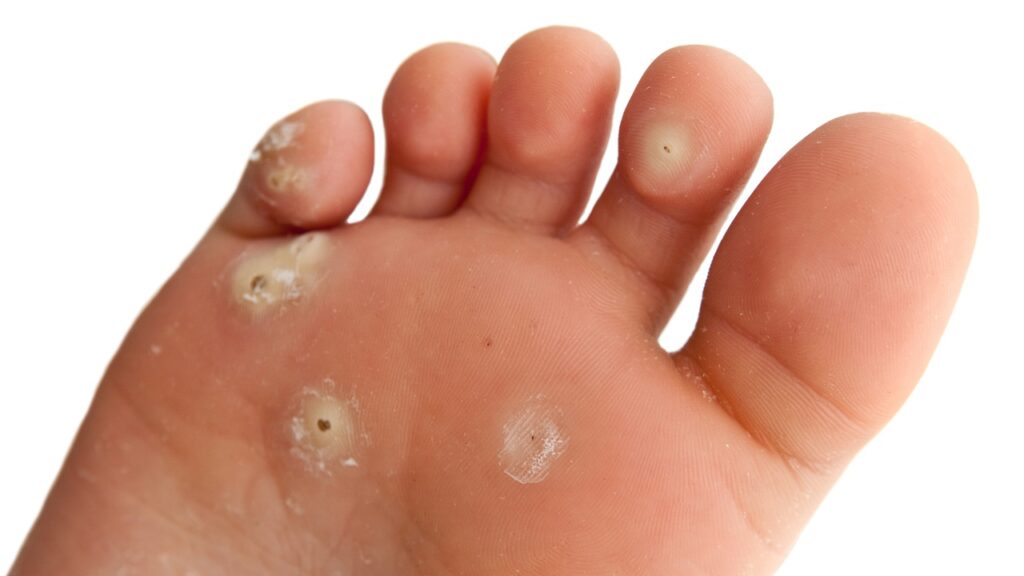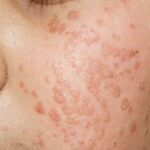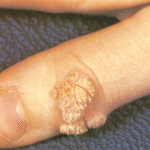Verruca plantaris, commonly referred to as plantar warts, is a type of benign skin lesion caused by infection with the human papillomavirus (HPV). Unlike other warts, these appear on the sole (plantar surface) of the foot and are subject to constant pressure, which causes them to grow inward rather than outward. This inward growth often leads to pain and discomfort, especially when walking or standing.

Causes: Understanding HPV and Plantar Wart Formation
Verruca plantaris is primarily caused by HPV types 1, 2, 4, 27, and 57. The virus enters the body through small cuts or abrasions on the feet. Moist environments such as communal showers, swimming pool areas, and locker rooms provide ideal conditions for transmission.
Risk Factors:
- Walking barefoot in public areas
- Weakened immune system
- Excessive sweating (hyperhidrosis)
- Damaged or broken skin on the feet
- Children and adolescents are more commonly affected
Clinical Features of Plantar Warts
Plantar warts are distinct from other cutaneous warts due to their unique presentation under pressure points of the foot.
Key Characteristics:
- Rough, grainy texture
- Flat or depressed surface due to pressure
- Tiny black dots (thrombosed capillaries)
- Pain or tenderness when walking or standing
- Single lesion or mosaic pattern (multiple coalesced warts)
Types of Verruca Plantaris
| Type | Description |
|---|---|
| Solitary Wart | Single lesion with surrounding callus |
| Mosaic Wart | Cluster of multiple warts forming a plaque |
| Recurrent Wart | Wart reappearing after treatment |
Diagnosis of Verruca Plantaris
Diagnosis is typically clinical but may require further tools in atypical cases or when lesions are resistant to treatment.
Diagnostic Methods:
- Visual Inspection: Noting hallmark features like pinpoint hemorrhages
- Paring Test: Removing the superficial layer reveals vascular dots
- Dermatoscopy: Shows disrupted dermatoglyphics with capillary loops
- Biopsy (rare): Reserved for uncertain or atypical presentations
Differential Diagnosis
| Condition | Differentiating Factors |
|---|---|
| Corns/Calluses | Lack of vascular dots, more uniform texture |
| Plantar Fibroma | Deep, rubbery nodule |
| Foreign Body Reaction | Inflammatory signs around entry point |
| Malignant Melanoma | Irregular pigmentation and bleeding |
Plantar Wart Complications
- Persistent pain and discomfort
- Altered gait leading to secondary musculoskeletal issues
- Spread to other areas or individuals
- Resistance to conventional treatments in immunocompromised patients
Treatment Options for Verruca Plantaris
1. Topical Treatments
- Salicylic Acid: Keratolytic agent; most commonly used
- Cantharidin: Causes blistering, lifting wart off skin
- Imiquimod: Immune response modulator for resistant warts
2. Cryotherapy
- Application of liquid nitrogen
- Causes blistering and necrosis
- Multiple sessions typically required
3. Laser Therapy
- Pulsed dye laser: Destroys blood supply to wart
- CO₂ laser: Vaporizes wart tissue precisely
4. Surgical Options
- Curettage: Scraping out the wart
- Electrosurgery: Burning wart with electric current
- Risk of scarring and recurrence
5. Immunotherapy
- Used for recalcitrant warts
- Includes intralesional injections of antigens like Candida or MMR
- Stimulates systemic immune response
Home Remedies and Over-the-Counter Options
Though less potent than medical interventions, some over-the-counter treatments can be effective in mild cases:
- Salicylic acid plasters
- Duct tape occlusion therapy
- Apple cider vinegar (anecdotal evidence)
Caution is advised to prevent skin damage, especially in diabetic patients or those with poor circulation.
Prognosis and Natural Course
Plantar warts can resolve spontaneously within 1 to 2 years in immunocompetent individuals. However, due to their painful nature, intervention is often sought sooner. Early treatment can reduce the duration of symptoms and the risk of spreading.
Preventing Verruca Plantaris
Practical Prevention Tips:
- Wear flip-flops in communal showers and pools
- Avoid sharing socks or footwear
- Keep feet dry and clean
- Treat hyperhidrosis to reduce viral proliferation
- Disinfect surfaces prone to barefoot traffic
Special Considerations in Pediatric and Immunocompromised Patients
- Children: Treatment must balance effectiveness with comfort; often resolved without aggressive interventions.
- Immunocompromised individuals: May require systemic and combination therapies due to treatment resistance and rapid spread.
Frequently Asked Questions:
Are plantar warts contagious?
Yes. They spread via direct contact with contaminated surfaces or autoinoculation.
Do plantar warts go away on their own?
In many cases, yes. However, treatment is recommended to alleviate pain and prevent spread.
What’s the most effective treatment?
Cryotherapy and salicylic acid remain first-line treatments. Recalcitrant cases may benefit from immunotherapy or laser therapy.
How do I know it’s a plantar wart and not a corn?
Warts interrupt skin lines and display black dots (thrombosed capillaries), unlike corns.
Can I exercise with a plantar wart?
Yes, but high-impact activities may increase discomfort. Cushioning and padding can help reduce pain.
Verruca plantaris is a common and often painful foot condition caused by HPV infection. Through early recognition, appropriate treatment, and preventive strategies, individuals can effectively manage and eliminate plantar warts. A combination of therapeutic approaches tailored to the patient’s needs offers the best outcome, particularly in persistent or complex cases.

